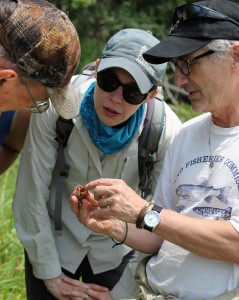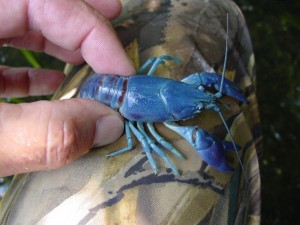We have been conducting Queensnake searches in the Maitland River for several years now. Along with that, we have also been studying crayfish. The reason for that is that the diet of the snakes is almost entirely freshly molted crayfish. This happens several times a year for young, rapidly growing crayfish and once a year for adult males after mating. There are three species of crayfish in the river, and a fourth, the rusty crayfish, is an invasive that we keep an eye out for. So far, we have not seen it, which is good.
Crayfish are normally a drab olive and brown colour, but every now and then we come across one that is a bright sky-blue all over. This invariably sparks a discussion amongst the researchers as to the cause. Is it something in their diet, something about where they are living, or some other reason? This has remained a mystery … until now. There was a Queensnake Training Day held recently, with the hands-on portion of the program taking place in the Maitland River. There will be several teams of researchers studying Queensnakes in a number of different watersheds, so they had to learn the required protocols. The crayfish portion of the training was handled by Dr. Premek Hamr, who is Ontario’s leading crayfish expert.

Dr. Hamr demonstrates how to identify each species of crayfish to onlooking biologists. Photo by Jory Mullen
As the ‘crayfish man’ and I were walking along in the shallow water and scanning rocks for crayfish, I couldn’t resist asking about the blue ones. Premek responded that it was an extremely rare genetic trait, with maybe one occurrence in many thousands. He also said that they are highly prized for aquariums. Several steps later, I spotted a bright blue claw laying on the bottom of the river. After a minute, the rest of the crayfish’s remains were found. Premek examined it and commented, “Too bad something got it. It would have been great in a tank.” So I now have a better understanding of one of the Maitland River’s many fascinating critters.
– Tom Lobb, Landowner and local Naturalist
To learn more about the Queensnake project in the Lower Maitland River, visit the Huron Stewardship Council website: old.huronstewardship.ca.

